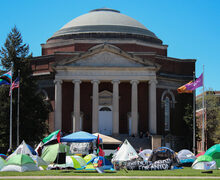Student contact tracers hope to be a trustworthy resource for SU community
Will Fudge | Staff Photographer
A group of 30 students will assist SU in its effort to track the spread of coronavirus among students.
The Daily Orange is a nonprofit newsroom that receives no funding from Syracuse University. Consider donating today to support our mission.
Taylor Spires joined Syracuse University’s coronavirus contact tracing team because she wanted to protect the city she grew up in.
Spires, a Syracuse resident and SU student, worried that the return of students to campus this fall could potentially lead to a renewed COVID-19 outbreak in the city. When she heard SU was launching a contact tracing team to mitigate the virus’ spread on campus, she signed up.
“It was kind of intriguing to be a part of something that was really important, not just to me as a student and to my fellow students, but to the community that I consider to be my home,” said Spires, a senior biochemistry major.
A group of 30 students will assist SU in its ongoing efforts to track the spread of COVID-19 on campus during the fall semester, said Adam Florkowski, the contact tracing team’s supervisor. The tracers are responsible for working with infected students to identify others who may have come in contact with the virus.
Although the team’s members have received training, they have not yet begun contact tracing due to the low number of confirmed infections among students, Spires said. Only 0.24% of SU students had tested positive for the virus as of Saturday, and the university has isolated all infections, a university official told The Daily Orange.
The tracing team’s members have been trained to conduct “contact calls,” during which they ask infected students about their medical history and the places they’ve visited in the past two weeks. The tracers will also request the contact information of people who may have been exposed to the virus.
After identifying a close contact of an infected student, tracers will reach out to the contact so they can be relocated to the university’s quarantine housing. If a student interacted with people other than SU students, the tracers will refer the contact to Onondaga County’s contact tracing team.

A contact tracer handles a pooled saliva COVID-19 test. Will Fudge | Staff Photographer
The contact tracers’ role as students makes communicating with other students who may have been exposed to COVID-19 easier, Spires said. The team can build rapport with students who may otherwise feel uncomfortable answering questions from university officials.
“From one student to another, you build that trust-making,” said Dom Donnay, a sophomore public health and biology major and a member of the contact tracing team. “You make sure that the students are comfortable with disclosing information to you and that everything shared between them is confidential.”
For the contact tracing process to be as accurate as possible, students may have to tell contact tracers if they’ve violated the university’s “Stay Safe Pledge” by not social distancing, not wearing a mask or attending a gathering with more than 25 people. SU has already placed at least 23 students on interim suspension for violating these guidelines.
Students may be afraid to share information out of fear of repercussions for themselves or their friends, Spires said. But contact tracers aren’t allowed to share information about the students they interview with anyone else. The team’s only job is to identify at-risk students so they can be placed in quarantine.
“We’re not trying to get anyone in trouble,” Spires said. “We just want to stay on campus. We want to stop the spread before it gets overwhelming.”
The contact tracers also help the university conduct COVID-19 saliva screenings, answer students’ testing questions and check in on students in quarantine, said Caitlin Mogan, a graduate student and a member of the team.
To become contact tracers, members of the team participated in online meetings with public health professors and took a six-hour online course through Johns Hopkins University’s Bloomberg School of Public Health.
Students don’t have to have a background in public health to become a contact tracer, Mogan said. Members of the team come from several different schools and majors within SU.
“It’s a really good collaborative environment,” Mogan said. “The people who don’t have the public health background are obviously learning a lot about the public health side. But the people who have the public health background are learning from the people who don’t.”
When looking for contact tracers, SU sought out students who are able to communicate effectively and who are comfortable speaking with strangers.
Empathy is also important to the job, Mogan said.
“I feel pretty confident that this team is going to do everything we possibly can,” Mogan said. “We all understand why our work is important and why we need to be doing it to our best ability.”
The contact tracers are now learning how to input the information they receive from interviewed students into a data entry system that the Barnes Center at The Arch uses to track medical records.
Spires is confident that the team will help prevent the spread of the virus at SU, but only if students cooperate.
“On our end, we have a good plan in place,” she said. “A lot of it really relies on the students and their willingness to give information on who they’ve been in contact with.”
Published on August 25, 2020 at 9:09 pm
Contact Abby: [email protected] | @abbyweiss_21





